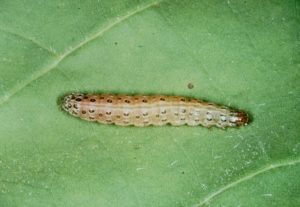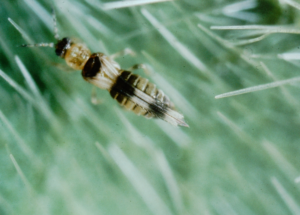Soybean Insects: Early-Season Pests (Emergence to V8)
Lesser Cornstalk Borer, Elasmopalpus lignosellus
Lesser cornstalk borer larvae (Fig. 8) are bluish with distinct abdominal segments. Full-grown larvae are about 1/2 to ¾ inch long. Damage occurs when larvae bore near ground level into the main stems of young soybeans, resulting in wilting, lodging (plants fall over), and plant death (Fig. 9). Affected plants are often grouped in the same or adjacent rows because individual larvae can attack more than one plant (Fig. 10). Sometimes dead plants appear teepee- shaped.Larvae inhabit silken tubes in the soil, which are attached to the plant. Since larvae can survive on decaying vegetation, early field preparation can help prevent damaging infestations.
Because damage usually occurs during hot, dry weather, irrigating soybeans can help prevent injury. Soybeans grown on sandy soils can be more vulnerable to attack than those grown on finer soils. Since soybeans should have no fewer than four plants per foot of row for profitable yields, sparse, non-uniform stands of soybeans can tolerate less damage than denser, uniform stands. Insecticides applied to the seed and also applied post-emergence are available. Careful scout- ing during early soybean growth can detect developing populations before injury occurs.
Cutworms (various species)
Cutworms are the larval stages of moths that feed below or near ground level on the roots and stems of seedling soybeans (Fig. 11). Damage results in soybeans being “cut-off.” Affected plants that remain standing can appear drought-stricken.
As with all caterpillars, the larger they are, the more damage they can do. Full-grown caterpillars are relatively large (1½ inches long), dark (blending well with dark soil), and often curl up into a “C” shape when disturbed.
During the heat of the day, these caterpillars remain in the soil feeding below ground level. To find the larvae, dig up seedlings along with their roots during daylight hours.
Damage can occur quickly; scout the crop from planting to well into the vegetative stages of development. Replanting may be neces- sary where cutworms reduce stands to less than four plants per foot of row.
Usually, you can find cutworms in finer soils (loamy/clay) during dry conditions that coincide with planting, emergence, and early seed- ling growth. The moths are dark and triangular-shaped with the wings held flat over the abdomen. Since cutworms tend to lay eggs in crop residue, planting into fields with plant residue (such as conservation tillage) can increase the chance of cutworm damage.
Certain granular and foliar insecticides are available. Apply these insecticides late in the afternoon or evening when the larvae feed above ground. In addition, to improve the coverage of liquid formula- tions, apply the maximum labeled final spray volumes.
Garden Webworm, Achyra rantalis
Garden webworms (Fig. 12) feed on the foliage of seedling soybeans. Severe damage, although uncommon, can result in stand loss. Full-grown larvae are about 1 inch long, yellow or pale green with a light-colored stripe running along the middle of the top of the body, and dark, circular plates in triangular patterns on either side of each body segment.
The larvae often produce webs that bind foliage and offer some degree of protection from natural enemies and adverse weather.
No treatment thresholds exist, but scout for these pests as soon as soybeans emerge and apply an insecticide if larvae are abundant and stands are threatened.
Thrips (various species)
Thrips are small, slender insects about 1/16 inch long. Adults have fringed wings you can see with a hand lens (Fig. 13). They have rasp- ing and sucking mouthparts they use to abrade tender plant tissue and sop up leaking plant fluids.
Leaves damaged by thrips (Fig. 14) are deformed and have silvery areas. Damaged foliage often has thrips excrement, which looks like small grains of black pepper.
Many thrips species can occur in soybeans, but most are not of economic importance. In fact, some thrips are beneficial predators. Since early-season thrips have not been found to cause yield loss, insecticidal seed treatment for thrips control may not be justified.
In Calhoun County, Texas, thrips have infested some drought- stressed fields at levels that reduced yields. These populations occurred later in the growing season and caused premature defoli- ation of the affected plants. Drought stress may have been a factor, since all the fields with higher thrips populations suffered from a lack of soil moisture.






